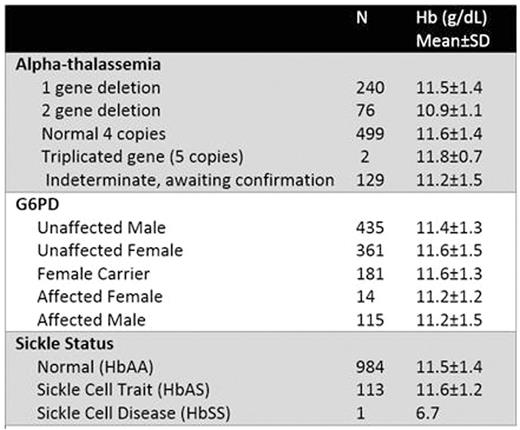Abstract
CCHMC IRB Protocol
Background: Anemia is an important contributor to morbidity and mortality among young children in sub-Saharan Africa. Although nutritional and environmental etiologies of anemia are common, the causes are multi-factorial and include inherited blood disorders that are thought to be prevalent across sub-Saharan Africa.There are few data across Africa, including Malawi, regarding the prevalence of inherited blood disorders and contributions to anemia burden.
Methods: The Malawi Demographic and Health Survey (MHDS) was conducted between October 2015 and February 2016 by the Malawi National Statistical Office in collaboration with the Community Health Services Unit of the Ministry of Health. The MHDS included a sub-study to investigate the nutritional and genetic causes of anemia. For the substudy, 105 clusters were randomly selected from the MHDS sample. In each cluster, 21 households were randomly selected and all eligible children 6-59 months were enrolled. Following visits to each household for informed consent, children were brought to the field lab for assessment of anthropometry and venous blood collection. Hemoglobin concentration was measured by the Hemocue device, and 200µL was spotted onto dried bloodspots (DBS). The DBS were frozen, and samples were transported to the US for DNA extraction and genetic analyses. DNA was extracted from DBS using two 3mm punches and frozen at -85C. Genetic causes of anemia were determined using a combination of PCR-based techniques: HbS allele (rs334) using TaqMan RT-PCR analysis; G6PD deficiency (A- variant) using 3 TaqMan RT-PCR analyses for G202A (rs1050829) to distinguish A and B isoforms followed by A376G (rs1050828) to identify the A- variant, and gender (SRY_VIC, ABCD1_CCHS0H-FAM); and deletional -α3.7-thalassemia using a copy-number variant RT-PCR assay with probes inside and outside the α-globin region (Hs03947236_cn, HbA_Tri_CCPAD0C).
Results:Of 1263 children for whom informed consent was obtained, 1137 ultimately had adequate bloodspots collected for molecular analyses. The mean (±SD) hemoglobin concentration for the entire cohort was 11.5±1.7 g/dL. Twenty nine percent of all children (355/1205) were anemic (Hb<11 g/dL). A majority of anemic children (212/355, 59.7%) had mild anemia (Hb 10-11 g/dL), while 134 (37.7%) had moderate anemia (Hb 7.0-9.9 g/dL) and 2.5% (9 children) had severe anemia (Hb<7 g/dL). The allele frequency for the G6PD A- variant was 0.19 for the entire cohort, while G6PD deficiency was present in 20.8% of males and 2.5% of females with a female carrier rate of 32.2%. Alpha-thalassemia trait was found in 33.5% of children, including 25.6% with a single α-globin gene deletion (α-/αα) and 8.0% of children with a two gene deletion (α-/α-). The HbS allele frequency was 0.05 with a carrier rate (sickle cell trait, HbAS) of 10.1%. The table summarizes the hemoglobin concentrations according to each inherited hematological condition (for the samples that had both genetic analyses and hemoglobin concentrations measured). Alpha-thalassemia status was associated with a significantly lower hemoglobin concentration compared to non-carriers. Further data on the frequency of other common nutritional deficiencies (iron, vitamin A) and infectious (malaria, hookworm) causes of anemia are currently being analyzed.
Conclusions: Anemia is a common and multi-factorial problem in Malawian children. In addition to nutritional and other environmental factors, this study demonstrates that genetic causes of anemia are common in this cohort of children. As expected, alpha-thalassemia trait is associated with decreased hemoglobin concentration, while steady state G6PD deficiency and sickle cell trait are not associated with anemia. The importance and frequency of these inherited hematological disorders is underappreciated in Malawi and across sub-Saharan Africa and should be considered when evaluating the prevalence and management of anemia in African children. Larger scale surveillance of these disorders with careful geospatial mapping will be important to further describe the incidence, co-inheritance, and clinical significance of these common inherited hematological disorders.
Ware:Addmedica: Research Funding; Biomedomics: Research Funding; Global Blood Therapeutics: Consultancy; Nova Laboratories: Consultancy; Bristol Myers Squibb: Research Funding; Bayer Pharmaceuticals: Consultancy.
Author notes
Asterisk with author names denotes non-ASH members.


This feature is available to Subscribers Only
Sign In or Create an Account Close Modal